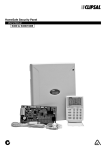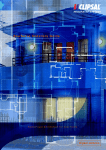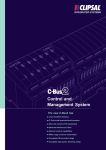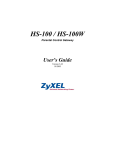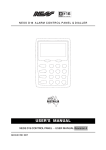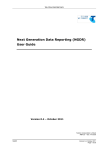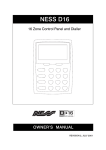Download Clipsal 5400 Series User`s guide
Transcript
HomeSafe Security Panel User’s Guide 5400 Series CONTENTS Features ...................................................................... 4 Introduction ................................................................. 5 Keypad ........................................................................ 6 Keypad Indicators ...................................................... 7 OPERATION by KEYPAD ........................................... 8 Arming ...................................................................... 9 Disarming .............................................................. 10 Resetting Alarms ................................................... 10 Monitor Mode ........................................................ 11 Panic ...................................................................... 12 Duress .................................................................... 12 Fire Alarm .............................................................. 13 Medical Alarm ....................................................... 13 Excluding Zones ................................................... 14 Alarm Memory ....................................................... 15 OPERATION by RADIO KEY ..................................... 16 PROGRAMMING ....................................................... 17 Programming Options Table ................................ 17 User Code programming ...................................... 18 Entry/Exit Timer programming ............................. 18 Telephone Number programming ....................... 19 Monitoring, Central Station ...................................... 20 Monitoring, Audible .................................................. 21 Wireless Accessories ............................................... 20 Remote Operation by Telephone ............................ 22 CLIPSAL ACCESSORIES ......................................... 24 Wireless Accessories ........................................... 25 Troubleshooting ........................................................ 26 Installation Record .................................................... 27 OPERATION SUMMARY .......................................... 28 CLIPSAL 5400 FEATURES • 8 Fully programmable zones • Any combination of hardwire or radio zones • • Comes complete with an AC plug pack and supports a 12V 7Ah battery to maintain systems security under all power supply conditions Full radio supervision • Monitor Mode (Home Mode) • Contact ID Dialler Format • Outputs are separately fused with Automatic Reset Fuses • Ultra-Modern and Impact resistant Housing • Day Mode and Door Chime feature. • Audible Dialler Output Option • 30 Event Memory • "Follow Me" Audible Dialler Option • • Separate 24 Hour Tamper input Supports 8 Radio Devices (Radio PIRs, Radio Reeds etc) • Single or Double Trigger Zones • Supports 14 Radio Keys • • Remote LED or LCD Keypads (Max 3) • Fully programmable via the system Keypad - Eliminates the need for expensive programmers or Proms. All inputs and outputs are heavily protected against lightning and high voltage supply transients. An earth terminal is provided for extra protection • Inbuilt Vibration Sensor Analyser • 15 User Codes • All programming data is permanently stored in a non-volatile ee prom memory • ‘Arm only’ codes can be programmed • Programmable Inputs to activate selectable Outputs • Designed utilising the latest SMD Technology • Simple to Program and Use. • Windows based Up\Download Software allows remote programming and event status • True Dynamic Battery Test every time the Panel is armed / disarmed and every hour • Area Partitionable (2 Areas). Any Zone can be programmed to any area, as well as common areas 4 Clipsal 5400 HomeSafe Security Panel - USER Guide INTRODUCTION The Clipsal 5400 HomeSafe micro computer based 8 zone control panel is the heart of your security system to which all your detection devices connect. Arming the system may be done through the keypad or with the use of optional Radio Keys for Arming by remote control from outside the premises. Each Zone of the panel can be connected to one or more detection devices to protect separate rooms of your premises. When you enter the premises the panel will ignore selected zones for the Entry Delay Time and will not alarm unless you don’t Disarm the panel during this allowed time. Detection devices may be connected to the 5400 HomeSafe Security Panel directly by cabling or with optional wireless (Radio) devices. Detection devices called Passive Infra-Red Detectors (or P.I.R’s for short) can detect the movement of an intruder by sensing their body heat. P.I.R’s are used to cover various critical areas of your premises where an intruder may enter or trespass. Another detection device used is called a Reed Switch. Reed Switches are attached to windows and doors to detect if a window or door has been opened. A Reed Switch consists of a magnet which is normally attached to the moving part of a window or door and the Reed switch which mounts to the door or window frame. The panel is “Armed” when it is set to detect an intruder. At other times it is “Disarmed”. Normally a zone is considered Sealed. Activation of a detection device will cause the zone to be Unsealed and may cause an alarm. Detectors such as fire detectors and panic buttons must be able to generate an alarm at all times regardless of the panel setting. A zone with this assignment is called a 24 hour zone. Some detection devices may be required to generate an alarm or warning only when the panel is Disarmed. A zone with this assignment is called a Day zone. Before leaving the premises you must Arm the panel to enable it to detect intruders and generate an alarm. After arming, the panel will ignore detectors during the Exit Delay Time to enable you to depart without triggering an alarm. Disarming the system may be done by keypad or with the use of optional Radio Keys. Monitor mode allows you to Arm selected zones while others are ignored. Typically, perimeter zones (doors and windows) can be monitored while you are at home. If you wish to split your alarm system into two areas with access limited to each area by code numbers then Area operation is used. Radio Keys can also Arm and Disarm Areas. The control panel housing and the covers over external sirens are protected by tamper switches to detect someone attempting to disable the security system. Activation of these switches will cause an instant tamper alarm. If a detector becomes faulty, you can Exclude the associated zone so that it is totally ignored and cannot generate an alarm. Including the zone will enable it to generate an alarm again. The control panel is fitted with a rechargeable stand-by battery to ensure your security system continues to operate if the mains power is interrupted. This control panel automatically tests the battery every hour and whenever you Arm/Disarm the panel (Dynamic Battery test). Whenever an alarm occurs, it may be silenced with a User Code or by optional Radio Keys, otherwise it will reset at the end of Alarm Reset Time. All alarms are stored in memory and may be viewed at any time by entering Memory Mode. Clipsal 5400 HomeSafe Security Panel - USER Guide 5 KEYPAD The 5400 HomeSafe Security Panel may be supplied with either the 5410KP Keypad, or the 5412KP Keypad. The keypad provides important visual and audible indications and is the main interface for operating and programming the 5400 control panel. DISPLAY TEST (LCD Keypad only) To display all the keypad icons press and hold the button for at least 2 seconds. All the icons will be on whilst the button is held down. Display Test can be activated at any time either in operating mode or any program mode. 6 Clipsal 5400 HomeSafe Security Panel - USER Guide KEYPAD INDICATORS Clipsal 5400 HomeSafe Security Panel - USER Guide 7 OPERATION This section describes the operation of a USER CODE ASSIGNMENT typical control panel installation. Keep in A User Code assigned to an Area can Arm and Disarm only that Area. User Codes assigned to both Areas will operate both Areas simultaneously. mind that your installation may vary depending on the selected options and equipment. The operating instructions which follow will cover the most common options. Consult your installation company if you require further information. All security panel operations are controlled by the LED or LCD keypad except if an optional key switch or radio control equipment is installed. OPERATING RULES Generally, the panel will be Disarmed. Armed or Monitor modes provide different levels of security for your premises when you are home or away. Three other temporary modes; Program, Memory and Exclude, allow you to perform various operations. The panel will automatically exit from these temporary modes if you do not press any buttons on the keypad in a 4 minute period. If you make a mistake while entering any codes, press the Enter or E button and start again. When you are required to enter your access code, you are given five opportunities to enter it correctly. After the fifth invalid attempt the alarm is activated (requiring the correct code to silence the alarm). This prevents anyone trying to guess your code by entering random numbers. COMMON AREA ZONES Zones assigned to both Areas are Armed only when Area1 and Area2 are both Armed. This allows the Common Area zone/s to be shared by both Areas. For example, Office A and Office B operate as separate areas but the entrance foyer used by both offices is assigned to both areas meaning it will automatically Arm when both Areas have Armed. The Common Area then automatically disarms when either Area1 or Area2 Disarms. OPERATION Arming and Disarming is carried out as normal from a single keypad or separate keypads installed in both areas or by Radio Key. Area operation only applies to zones when they are in the Armed state. This means that Day, 24hr and Monitor zones are independent of the area operations. Note: Area partitioning is in addition to Monitor Mode. Any zone may be allocated to any area. AREA OPERATION Area Partitioning allows the 8 zones to be split into two partitions; Area1 and Area2. The panel then effectively operates as two separate systems sharing only the siren outputs and dialler. 8 Clipsal 5400 HomeSafe Security Panel - USER Guide OPERATION The control panel must be Armed prior to vacating the premises in order to detect intruders. Ensure that the panel is not in Program, Memory or Exclude modes. Note: If the panel is already in alarm, you must first silence the alarm before you can Arm. If something is wrong when Arming the control panel, the normal 3 beeps will be replaced by other warnings. 10 beeps means Mains Power is turned off or the Backup Battery is low. SIREN WARNING: At the end of the exit time, all zones should be Sealed. If any are Unsealed, the siren will sound for 2 seconds as a warning to indicate that those zones have been automatically excluded. For maximum security, you should return, Disarm, check the premises and then Arm again. Continual warnings could mean that a detector is faulty and may have to be manually excluded. If the auto-exclude option is disabled, the siren will sound for the duration of reset time if a zone is Unsealed at the end of exit time. One long beep indicates an invalid entry or an alarm is outstanding and needs to be reset by entering your User Code first. Clipsal 5400 HomeSafe Security Panel - USER Guide 9 OPERATION When you enter the protected premises through a delay zone, the keypad responds with regular beeps* as a reminder to Disarm. You then have your programmed entry delay time to Disarm the panel by entering one of your user codes. If the panel is not Disarmed by the end of the entry delay time, an alarm will occur. By using the optional radio keys you may Disarm your system from within your premises or from outside your entrance door. There is also the option to ‘Chirp’ the outside siren three times and to flash the strobe light for two seconds as an indication that you have Disarmed your system. If you make a mistake in entering your code, then you must press enter and start again. Five incorrect entries will cause an alarm. * If Entry Beeps are programmed on. RESETTING ALARMS ALARMS, DEFINITION Your panel can be reset and the alarm silenced by the same key sequence as Disarming the panel. Alarms may be caused by: If you arrive at your premises and find the strobe light flashing (if installed), reset the panel as above. To check the cause of the alarm, you can view the alarms in memory by entering Memory Mode. 10 • A zone has been triggered while Armed • A Tamper has been triggered • A PANIC button has been triggered All of these may cause your sirens and strobe to operate. Various visual indications relevant to the alarm will be retained in the memory. If this occurs, Disarming your control panel will reset the alarm. The cause of the alarm can be identified by entering the Alarm Memory Mode as described on page 15. Clipsal 5400 HomeSafe Security Panel - USER Guide OPERATION Monitor mode allows you to Arm selected zones while others are ignored. Typically, perimeter zones (doors and windows) can be monitored while you are at home. If an alarm occurs while in Monitor mode, Your installer must program which zones will be active in Monitor mode. By using the optional Radio Keys you can enter Monitor Mode by pressing the OFF button twice within 4 seconds. (Your installer must enable Radio Key Monitor Arming for this to work). The panel must be fully Disarmed before Arming in Monitor Mode. entering [User Code] will silence the alarm. This will also Disarm the panel, so remember to enter monitor again if needed. Clipsal 5400 HomeSafe Security Panel - USER Guide 11 OPERATION The keypad PANIC function may have been programmed to be either AUDIBLE - activates siren or buzzers, or SILENT - If your system is monitored by a Central Station, sends a PANIC report by dialler. (If PANIC reports have been enabled by your installer). PANIC cannot be used while the panel is in Program, Memory or Exclude mode. A DURESS alarm can be triggered to alert the Central Station that you are being forced to Disarm the panel against your will. DURESS alarms are only used if your system is monitored by a Central Station. To Disarm and send a DURESS alarm, prefix your User Code with one of the digits 5, 6, 8 or 9 when Disarming. 12 Note: Your installer may have installed a separate PANIC button. To activate the panic alarm simply press that button. DURESS IS NORMALLY NOT ENABLED. TO ENABLE THE DURESS FUNCTION, CONSULT YOUR INSTALLER Clipsal 5400 HomeSafe Security Panel - USER Guide OPERATION Clipsal 5400 HomeSafe Security Panel - USER Guide 13 OPERATION If a detector becomes faulty and cannot be Sealed when arming the panel, then its zone may be Excluded so that it does not generate alarms. When zones have been Excluded, the EXCLUDE light flashes continuously while the panel is Disarmed and also when Armed. Zone Exclude IS not permanent. Excluded zones are automatically INCLUDED next time the panel is Disarmed. Zones can be manually included by the same method as Excluding. Simply use the sequence to turn OFF the [ZONE NUMBER] zone lights to be Included. Zones can only be Excluded when the panel is Disarmed. NOTES • EXCLUDE E works only when the panel is Disarmed. • EXCLUDE [User Code] E works in any state. • EXCLUDE [User Code] E can only exclude the zones in the Area assigned to that code. 14 Clipsal 5400 HomeSafe Security Panel - USER Guide OPERATION The 5400 Security Panel stores a comprehensive Alarm Memory, including Arming, Disarming, Low Battery, Mains Fail and Alarm events. TO CLEAR THE MEMORY LIGHT The MEMORY light flashes continuously when an alarm has occurred as a reminder to view the alarm memory. The memory is constantly upgraded and the last 30 events are always available for viewing. The MEMORY light stops flashing after the memory is viewed as shown above. This Memory display can only be selected while the panel is in the Disarmed state. The MEMORY light is automatically cleared next time the panel is Armed. Clipsal 5400 HomeSafe Security Panel - USER Guide 15 RADIO KEY OPERATION CLIPSAL RADIO KEY 3 BUTTON The optional Clipsal Radio Key allows you to Arm, Disarm and activate PANIC. The Radio Key can also Arm Monitor Mode, (if this has been enabled by your installer). ARMING Press the ON button. • The keypad will give 3 beeps. • The outside siren will give 1 ‘chirp’. (If enabled by your installer) • The strobe light will flash briefly DISARMING Press the OFF button. • The keypad will give 3 beeps. • The outside siren will give 3 ‘chirps’. (If enabled by your installer). • The strobe light will flash briefly. ARMING MONITOR MODE Press the OFF button twice within 4 seconds. • The keypad will give 9 beeps. • The outside siren will NOT ‘chirp’. • The strobe light will flash briefly. PANIC Press and hold the PANIC button for at least 4 seconds. • The siren and strobe will activate, (If enabled by your installer) • The dialler will report a Panic alarm, (If enabled by your installer and if your system is monitored by a central station). Press the OFF button to reset a Panic alarm * The Clipsal Radio Key is optional and is not supplied with any Clipsal HomeSafe panels as standard 16 Clipsal 5400 HomeSafe Security Panel - USER Guide PROGRAMMING Various system options, as listed below, can be programmed by the user. These options can only be accessed from Program Mode. User Codes may need to be re-programmed if a person has forgotten their code, to give a new user access to the system or to give someone temporary access. User Codes 2-15 can be set as Arm Only Codes. These codes can Arm but cannot Disarm the panel. (Useful for assigning to cleaners, tradesmen etc.) You may need to change the Entry and Exit timers if you find the delays are too long or short. If Audible Monitoring is programmed by your installer, the ‘Follow Me’ Telephone Number is the telephone number the dialler will call in the event of an alarm. If your Clipsal HomeSafe Security Panel is monitored by a Central Station, the Follow Me number is ignored. For all other programming changes, talk to your installer. The panel will automatically exit Program Mode is no buttons are pressed within a 4 minute period. FACTORY DEFAULT MASTER CODE IS: 123 PROGRAMMING OPTIONS TABLE NOTE: The Entry Delay 2 timer programs in 10 second intervals. Example: if a value of 6 is programmed, the time is 60 seconds. Clipsal 5400 HomeSafe Security Panel - USER Guide 17 PROGRAMMING 18 Clipsal 5400 HomeSafe Security Panel - USER Guide PROGRAMMING * For a list of option numbers, see the Programming Options Table on page 17 Clipsal 5400 HomeSafe Security Panel - USER Guide 19 MONITORING CENTRAL STATION MONITORING The 5400 HomeSafe Security Panel has an onboard digital dialler which can send detailed alarm messages to a Central Monitoring Station. The digital messages can include information about the zone or zones which caused the alarm, tamper alarms, low battery or mains failure reports, and it can also (by user number) identify the users who Arm and Disarm the system. Central Station Monitoring is highly recommended and is the most effective method of monitoring your 5400 alarm system. For further information about 24 hour monitoring, contact your installer or Clipsal Security Products. 20 Clipsal 5400 HomeSafe Security Panel - USER Guide AUDIBLE MONITORING The 5400 HomeSafe Security Panel can also be programmed to send audible messages to any telephone or mobile phone. When programmed for audible monitoring, the panel calls a pre-programmed number (or numbers) and sounds a series of beeps over the phone. These beeps can identify the zone or zones which caused the alarm and well as several other alarm types. FOLLOW ME TELEPHONE NUMBER The Follow Me Telephone Number is the telephone number to which the 5400 sends alarm reports when Audible Monitoring is enabled. The Follow Me Telephone Number can be changed by the user in User Program Mode. If the Follow Me Telephone Number is programmed, the Primary and Secondary telephone numbers are ignored, even if programmed. (When Audible Monitoring is enabled). See page 19 for information on programming the Follow Me Telephone Number. AUDIBLE MONITORING SEQUENCE When triggered by an alarm, the 5400 will dial the programmed telephone number/s and output the audible message for 45 seconds or until it is acknowledged. ACKNOWLEDGING THE ALARM * The Primary and Secondary telephone numbers are normally only used for central station monitoring. These numbers can only be programmed in Installer Program Mode. ** The Follow Me Telephone Number replaces the Primary AND Secondary telephone numbers. The person receiving the call can then key acknowledge the alarm by pressing the on their telephone. Press the key for at least 2 seconds during pauses in the audible message. If the alarm is not acknowledged, the keypad’s LINE light will flash continuously until the panel is next Armed. Clipsal 5400 HomeSafe Security Panel - USER Guide 21 REMOTE OPERATION OPERATING THE 5400 BY TELEPHONE The 5400 will allow a user to call in to the panel, using a standard DTMF telephone, and remotely Arm or Disarm all areas and also turn on or off Aux 1 and Aux 2. To ensure security of operation a user can only carry out remote operations after entering a valid user code. WHAT’S NEEDED: • A telephone with DTMF tones. • A Valid User code programmed in the 5400. • The 5400 to be connected (via Mode 3 socket) to a working telephone line at the installed premises. • You need to know the telephone number of the line that the 5400 is connected to. SEQUENCE OF OPERATION. 1. Phone the 5400 telephone number and listen for the required number of rings (ring ring...ring ring) and then hang up. 2. Wait 10 seconds and then call the number again within 50 seconds. 3. The 5400 will answer the second call immediately, sound a beep for 2 seconds then, after a pause, it will sound a lower frequency tone. The 5400 is now ready to receive telephone commands. button on the telephone. This 4. Press the tells the 5400 that telephone commands will follow. It will respond with either 3 beeps if all OK (One long beep means try again). 5. Now enter a valid User Code (that is normally used for Arming or Disarming the 5400) followed by the button. The 5400 will respond with 3 beeps if it recognises the code or 1 long beep to signal the code was invalid and to try again. 6. Enter the required command. See: Summary Of Telephone Commands. 7. Press to finish. This tells the 5400 to hang up. Also, hang up your telephone. NOTES • If the 5400 does not receive commands for periods longer than 10 seconds it will assume that the call is finished and it will hang up. • If an alarm occurs which requires the 5400 to dial out while attempting remote control, the 5400 will treat the alarm as a priority, give a constant tone as a warning and then hang up. • When all remote control commands are finished press hang up. 22 to force the 5400 to Clipsal 5400 HomeSafe Security Panel - USER Guide REMOTE OPERATION EXAMPLE: ARMING THE 5400 BY TELEPHONE 1. Dial the 5400 telephone number. Listen for one double ring then hang up. 2. Wait 10 seconds, then dial the 5400 telephone number again. The 5400 will answer immediately and gives a 2 second beep followed by low tone. 3. PRESS To prepare the 5400 ( 4. PRESS [User Code] 3 beeps) to authorise the next command ( 5. PRESS to Arm the panel ( 6. PRESS to finish and hang up 3 beeps) 3 beeps) AUDIBLE FEEDBACK 3 BEEPS: • The User Code is valid • Successful Arming or Disarming • An Auxiliary output has been turned ON. 1 LONG BEEP: • 5400 is already Armed • Invalid code. Try again. 1 SHORT BEEP: • An Auxiliary output has been turned OFF. SUMMARY OF TELEPHONE COMMANDS Prepare to receive commands Arm Areas Disarm Areas Turn Aux 1 Output ON or OFF Turn Aux 2 Output ON or OFF Finished – hang up Clipsal 5400 HomeSafe Security Panel - USER Guide 23 TROUBLESHOOTING 24 Clipsal 5400 HomeSafe Security Panel - USER Guide INSTALLATION RECORD Clipsal 5400 HomeSafe Security Panel - USER Guide 25 OPERATION SUMMARY 26 Clipsal 5400 HomeSafe Security Panel - USER Guide Clipsal 5400 HomeSafe Security Panel - USER Guide 27 Products of Clipsal Integrated Systems Pty Ltd ABN 15 089 444 931 Head Office 12 Park Terrace, Bowden South Australia 5007 PO Box 103 Hindmarsh South Australia 5007 Telephone (08) 8269 0560 International +61 8 8269 0560 Facsimile International (08) 8346 0845 +61 8 8346 0845 Internet E-Mail www.clipsal.com/cis [email protected] Offices in all States NSW Sydney Albury VIC (02) 9794 9200 (02) 6041 2377 Melbourne (03) 9207 3200 Country Areas 1800 653 893 QLD Brisbane Townsville (07) 3244 7444 (07) 4729 3333 SA Adelaide (08) 8268 0400 WA Perth (08) 9442 4444 TAS Hobart Launceston (03) 6272 3177 (03) 6343 5900 NT Darwin (08) 8947 0278 International Enquiries Head Office Telephone Facsimile E-Mail Export Department +61 8 8269 0587 +61 8 8340 7350 [email protected] New Zealand Clipsal Industries (NZ) Ltd (Auckland) Telephone +64 9 576 3403 Facsimile +64 9 576 1015 E-Mail [email protected] Customer Service Free Facsimile (0508) 250 305 Auckland/ Mobile Phone (09) 572 0014 Free Phone (0508) CLIPSAL 2547725 Malaysia Clipsal Integrated Systems (M) Sdn Bhd Level 3, Unit 3-2, C P Tower Jalan Damansara 46350 Petaling Jaya Telephone +61 603 7665 3555 Facsimile +61 603 7665 3155 E-Mail [email protected] Singapore CIS Pte Ltd (Singapore) No. 8, Jurong Town Hall Road #24-05-06 The JTC Summit Singapore 609434 Telephone +65 266 1998 Facsimile +65 266 3922 E-Mail [email protected] International Representatives China Clipsal China Ltd Telephone +86 755 246 1122 Greece Clipsal Hellas S.A. Telephone +30 1 993 9165 Hong Kong Clipsal Integrated Systems (HK) Limited Telephone +852 2 487 0261 South Africa Clipsal South Africa (Pty) Ltd Telephone +27 11 314 5200 Taiwan Clipsal (Taiwan) Co Ltd Telephone +886 2 2558 3456 Thailand Clipsal Thailand Ltd Telephone +66 2 952 5338 United Kingdom Clipsal Ltd (UK) Telephone +44 1494 521 111 You can find this brochure and many others online in PDF format at: clipsal.com Follow the links off the home page or access the following page directly: clipsal.com/ wat_lib_pdf.cfm clipsal.com/cis Clipsal Integrated Systems Pty Ltd reserves the right to change specifications, modify designs and discontinue items without incurring obligation and whilst every effort is made to ensure that descriptions, specifications and other information in this catalogue are correct, no warranty is given in respect thereof and the company shall not be liable for any error therein. ©Copyright Clipsal Integrated Systems Pty Ltd O/N 1036348 March 02/01




























